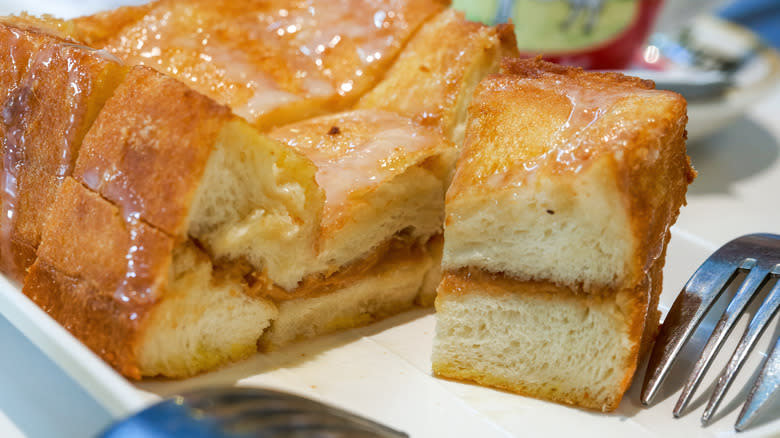Hong Kong-Style French Toast Is So Tasty, We'd Wake Up Early To Make It

Every culture has its own version of French toast. Pain perdu, eggy bread, or Poor Knights of Windsor are all made from pieces of bread in various stages of going stale, soaked in a loose, eggy custard, and fried until browned and delicious. Most are topped with sweet ingredients, like honey, syrup, powdered sugar, or sweet spreads like jam or Nutella. Hong Kong-style French toast takes the idea of French toast and turns it into a delectable layered, stuffed French toast.
Salty-sweet peanut butter is smeared between layers of white bread, soaked in custard, and then deep-fried on all sides until it's golden. It's usually topped with condensed milk and a pat of butter. The peanut butter is soft and runny, and the bread is delicately crispy without being overly sweet. It's like the French toast you always wanted as a kid. It's a popular street food or a post-bar munchie at 3 a.m. in Hong Kong, but you can make and enjoy it from the comfort of your own home.
Read more: How Other Parts Of The World Prepare Their Eggs
Pantry Staples Are All You Need For This International Treat

Hong Kong-style French toast is made with the most basic of French toast ingredients, which you probably already have on hand: bread -- usually shokupan, a.k.a. milk bread -- that's just started to go stale, eggs, milk, cinnamon, and butter. You'll also need some peanut butter and sweetened condensed milk, and that's about it for the most basic version of the dish, but you can go in other directions, too.
One good thing about Hong Kong-style French toast is that it's versatile and adaptable. If you don't like or can't eat peanut butter, use Nutella, or any other nut butter you prefer or can eat. Anything will work well as a filling, be it jam, chocolate, bananas; even Ovaltine spread is a popular choice as a filling. If you prefer a more sweet-savory contrast, you can use ham and cheese. You can find a salted egg yolk version, in which salted egg yolks are combined with milk powder, gelatin, cornstarch, and condensed milk before being added to the layers, resulting in a runny, salty-sweet egg-stuffed French toast. As for what goes on top, butter and condensed milk are the usual, but if you prefer your French toast with syrup or powdered sugar, that's an option, too.
If You Know How To Make French Toast, You Can Make Hong Kong-Style French Toast

Making Hong Kong-style French toast is similar to making "regular" French toast -- if you know how to do that, you can make this style of milk bread French toast. Though milk bread is most common, you can use any white bread. Before you fry, spread your preferred filling -- be it peanut butter, jam, or Nutella -- in a thin-ish layer (around a tablespoon) on two slices of bread and stack them on top of each other. Place the other piece of bread on top -- you should have alternating layers of bread and filling. Cut off the crusts, as they don't fry up well. Dunk this crustless triple-layer sandwich in a custard flavored with cinnamon, sugar, and milk or condensed milk, or you can just use whisked eggs. Make sure each side gets a turn in the custard and is evenly coated.
Though this French toast is deep fried in Hong Kong, you don't have to deep fry at home -- shallow frying in an inch of neutral oil will work just fine. Make sure each side gets some time directly on the pan and baste the hot oil on top of the toast so everything is crispy and golden. Top with a pat of butter and sweetened condensed milk or honey, and dig in.
Hong Kong-Style French Toast Traces Its Roots Its British History

Hong Kong-style French toast can be found in the cha chaan teng -- little diner-style eateries that proliferated in the 1950s -- that dot the city, a holdover from when the British controlled Hong Kong. When locals were banned from the eat-in restaurants and tea rooms frequented by the British elite and Chinese traders, they created their own Western-influenced eateries called bing sutt, or ice rooms. Since the owners couldn't afford restaurant licensing fees, the eateries operated as snack shops. They sold simple Cantonese-Western fusion food, usually a drink or small snack like toast, all featuring Western ingredients imported by the British. In the post-war boom of the 1950s, these bing sutt expanded into the cha chaan teng city residents frequent today for a quick bite or post-drinks meal. Even today you can see the British influence on the menus -- corned beef, Spam, and condensed and canned milk are frequently included in recipes.
The British brought French toast with them, but Western ingredients -- crusty bread, milk, whipped cream -- were expensive, so Cantonese cha chaan teng owners adapted the recipe to their ingredients and methods. They didn't use milk in the custard, and they used Cantonese bread, which is slightly chewier and softer, rather than a baguette. They deep-fried the French toast in woks and topped it with cheaper butter, and condensed milk or syrup, for a quick snack that appealed to locals and the British alike.
Read the original article on Mashed.

